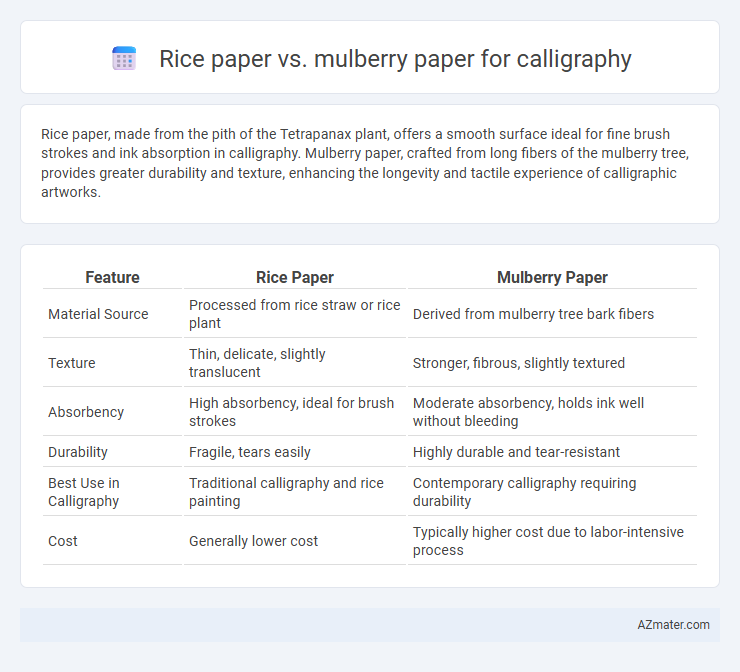Rice paper, made from the pith of the Tetrapanax plant, offers a smooth surface ideal for fine brush strokes and ink absorption in calligraphy. Mulberry paper, crafted from long fibers of the mulberry tree, provides greater durability and texture, enhancing the longevity and tactile experience of calligraphic artworks.
Table of Comparison
| Feature | Rice Paper | Mulberry Paper |
|---|---|---|
| Material Source | Processed from rice straw or rice plant | Derived from mulberry tree bark fibers |
| Texture | Thin, delicate, slightly translucent | Stronger, fibrous, slightly textured |
| Absorbency | High absorbency, ideal for brush strokes | Moderate absorbency, holds ink well without bleeding |
| Durability | Fragile, tears easily | Highly durable and tear-resistant |
| Best Use in Calligraphy | Traditional calligraphy and rice painting | Contemporary calligraphy requiring durability |
| Cost | Generally lower cost | Typically higher cost due to labor-intensive process |
Introduction to Calligraphy Paper Choices
Calligraphy paper choices significantly impact ink flow and stroke precision, with rice paper and mulberry paper being popular options. Rice paper, known for its smooth texture and absorbency, allows for delicate brush strokes and ink diffusion suited for detailed work. Mulberry paper offers enhanced durability and a fibrous surface that supports bold strokes and long-lasting calligraphy pieces.
What is Rice Paper?
Rice paper, traditionally made from the pith of the Tetrapanax papyrifer plant, is prized in calligraphy for its smooth texture and delicate absorbency, which allows ink to flow effortlessly and create sharp, clear strokes. Unlike mulberry paper, which is crafted from the bark fibers of the mulberry tree and known for its durability and texture, rice paper offers a more translucent quality that enhances the aesthetic appeal of brushwork. Its thin, lightweight nature makes it ideal for practicing detailed calligraphic techniques and creating refined, elegant artwork.
What is Mulberry Paper?
Mulberry paper, crafted from the inner bark of the Mulberry tree, is prized in calligraphy for its smooth texture and exceptional durability, allowing for precise brush strokes and ink absorption. Unlike rice paper, which is often made from various plant fibers and can be more fragile, mulberry paper offers a consistent surface that resists tearing and warping during artistic work. Its long fibers provide flexibility and strength, making it ideal for detailed calligraphy and traditional artwork requiring longevity and archival quality.
Key Material Differences: Rice vs Mulberry Paper
Rice paper, traditionally made from plant fibers like hemp or straw, offers a delicate, absorbent surface ideal for fluid ink flow in calligraphy, but it can be prone to tearing and uneven texture. Mulberry paper, derived from the bark of the mulberry tree, provides a more durable and flexible substrate with consistent fiber strength, enhancing ink retention and brush control. Differences in fiber composition and manufacturing processes create distinct tactile qualities, making mulberry paper preferable for detailed, long-lasting calligraphy works compared to the more fragile rice paper.
Surface Texture and Ink Absorption
Rice paper offers a smooth surface texture that allows for precise brush strokes, making it ideal for fine calligraphy work. Mulberry paper features a slightly coarser texture, which provides more resistance and control during writing but can result in more ink bleed. In terms of ink absorption, rice paper absorbs ink quickly, creating vibrant lines, while mulberry paper's moderate absorption helps maintain sharp edges without excessive spreading.
Durability and Longevity for Artworks
Mulberry paper offers superior durability and longevity compared to traditional rice paper, making it a preferred choice for calligraphy artworks intended to last. Its strong, fibrous texture resists tearing and aging, preserving ink vibrancy and preventing deterioration over time. Rice paper, while smooth and absorbent, tends to be more fragile and susceptible to yellowing and brittleness, which can compromise the artwork's lifespan.
Writing Experience: Brush Flow and Line Precision
Mulberry paper offers superior brush flow and line precision for calligraphy due to its strong, fibrous texture that holds ink without bleeding. Rice paper, while traditional, tends to absorb ink quickly, causing less control over brush strokes and slightly blurred lines. Artists seeking crisp, defined characters often prefer mulberry paper for its durability and consistent surface quality.
Color and Appearance: Effects on Artwork
Rice paper offers a smooth, translucent surface that enhances the delicate brush strokes in calligraphy, creating a subtle, ethereal effect with a natural off-white hue. Mulberry paper features a textured, fibrous appearance with a warm cream tone that adds depth and character to artwork, often emphasizing the contrast of ink and enriching the visual impact. The choice between rice paper's refined translucency and mulberry paper's organic texture significantly influences the color vibrancy and overall aesthetic of calligraphy pieces.
Best Uses for Rice Paper in Calligraphy
Rice paper, prized for its smooth texture and absorbency, is ideal for detailed brush strokes and intricate calligraphy work, allowing ink to flow seamlessly without blotting. Its lightweight, translucent quality enhances traditional East Asian ink calligraphy and sumi-e paintings, making it a favored choice for artists seeking precision and elegance. Best suited for fine line work and expressive brush techniques, rice paper excels in preserving the fluidity and gradation of ink in calligraphy.
Best Uses for Mulberry Paper in Calligraphy
Mulberry paper excels in calligraphy due to its smooth texture and strong fibers that prevent ink bleeding and feathering, ensuring precise, sharp strokes. It is best used for detailed brushwork and fine line calligraphy styles such as Japanese kana and Chinese seal script, where durability and ink absorption are critical. Its archival quality also makes it ideal for creating long-lasting calligraphy art and certificates.

Infographic: Rice paper vs Mulberry paper for Calligraphy
 azmater.com
azmater.com